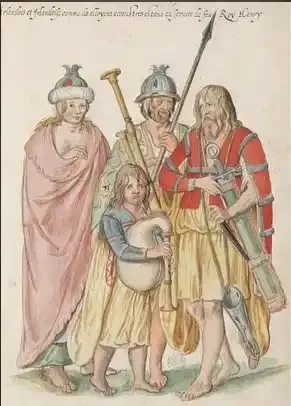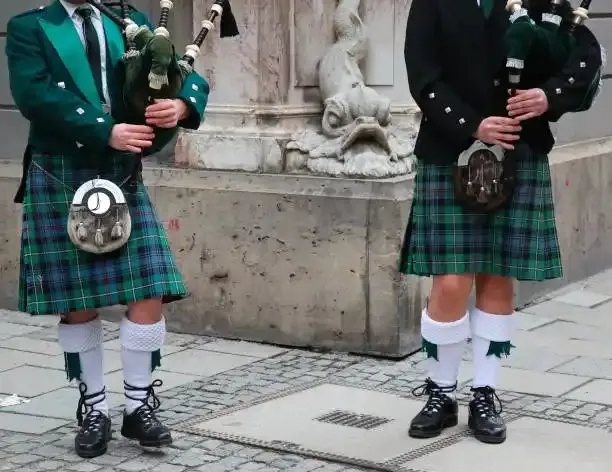Traditional Irish clothing
Traditional Irish clothing is deeply rooted in the country's rich culture and history. It reflects a unique blend of influences from various periods, including ancient Celtic traditions, medieval fashions, and later British colonial power. The traditional attire of Ireland not only serves as a representation of national identity but embodies its people's resilience and pride.
For men, one distinctive feature of traditional Irish dress was the long linen shirt, leine, or léine. Typically reaching below knee-length, these loose-fitting shirts were usually white or off-white and had wide sleeves gathered at the wrists using cuff bands called bráisléirí.
The iconic Aran sweater has become synonymous with Irish knitting traditions worldwide. Originating from the western Aran Islands off Ireland's coast, these hand-knit sweaters feature intricate cable patterns symbolic of life on the islands—representing fishermen's ropes or religious motifs like crosses for protection at sea.
Footwear plays no less importance within traditional Irish clothing styles. Historically, leather brogues were popular among men and women due to their durability and versatility across rural landscapes—a testament to practicality within fashion choices.
Accessories have always played a significant role in traditional Irish attire. For men, the caubeen—a beret—was frequently worn, often adorned with a feather or badge to signify membership in a particular group or organization. Women would embellish their outfits with ornate jewelry such as Celtic knot brooches, Claddagh rings symbolizing love and loyalty, and dainty filigree earrings.
While modern fashion trends have influenced contemporary Irish clothing choices, these traditional elements are celebrated and incorporated into garments today. Many designers draw inspiration from Ireland's rich cultural heritage when creating new collections, incorporating traditional patterns and fabrics into modern styles.
Overall, traditional Irish clothing represents more than mere apparel—it tells the story of Ireland itself. The intricate designs, vibrant colors, and unique garments serve as reminders of the nation's ancient traditions and its enduring spirit. Whether it be kilts, cloaks, sweaters, or accessories like caubeen or brooches, Irish culture's richness is beautifully expressed through its distinctive clothing style.
Traditional Irish clothing facts
i. One iconic piece of traditional Irish clothing is the kilt, although it may be more commonly associated with Scotland. The Irish kilt differs slightly from its Scottish counterpart, with tartan patterns and color variations. Historically worn by Gaelic-speaking men in Ireland, kilts were typically made from wool fabric and featured vibrant checkered designs representing different clans or regions.
ii. The brat or cloak is Another essential element of traditional Irish attire. This outer garment was traditionally made from coarse woolen fabric in earthy tones such as brown or grey. Cloaks protected against harsh weather conditions while also serving as a symbol of social status. Women often wore brightly colored shawls known as crios around their shoulders to add warmth and beauty to their outfits.
Traditional Irish clothing women
Traditional Irish clothing for women is steeped in history and cultural significance. It reflects Ireland's rich heritage and traditions, showcasing both practicality and elegance. From the ancient Celts to modern times, Irish women have worn distinct garments that embody their identity.
Brat
One iconic piece of traditional Irish clothing for women is the "Brat," a cloak-like garment made from wool or tweed. The Brat was traditionally worn on special occasions and served as protection against Ireland's unpredictable weather and a symbol of status and pride. Its length could vary, some reaching down to the ankles, while others were shorter for everyday use.
Leine
Another essential item in traditional Irish women's attire is the "Leine." This knee-length linen tunic was usually white or natural and featured billowing sleeves gathered at the wrists. The Leine was often decorated with intricate embroidery or lacework along its edges, adding a touch of femininity to its otherwise simple design.
Aran sweaters
For colder climates or harsher weather conditions, Irish women would don Aran sweaters. These intricately knitted sweaters originated off Ireland's west coast from the Aran Islands. They were traditionally made by hand using untreated wool from local sheep, which offered excellent insulation against cold winds and rain.
The distinctive feature of Aran sweaters is their complex patterns knitted into them—a combination of cables, diamonds, and honeycombs—an art form passed down through generations within island communities. Each pattern holds symbolic value; for example, diamond patterns represent wealth and success.
Kerry cap or Cailíní Beaga
Moving further south in Ireland to County Kerry gives us another notable part of traditional female attire: the "Kerry cap" or "Cailíní Beaga." This unique headpiece typically consisted of two parts—a soft-brimmed hat called a "Caubeen" accompanied by brightly colored ribbons tied beneath it.
The colors chosen for these ribbons held significance; unmarried women wore red, while married women wore green or black stripes. The Kerry cap was a distinctive regional identifier often complemented by accessories like shawls or brooches.
Claddagh ring
Lastly, no traditional Irish outfit would be complete without including a "Claddagh ring." This iconic piece of jewelry originated in the fishing village of Claddagh in Galway. It features two hands clasping a heart topped with a crown—an enduring symbol of love, loyalty, and friendship.
The Claddagh ring holds immense sentimental value for Irish women and is passed down through generations. Worn on the right hand with the heart facing outwards indicates the wearer's availability for courtship. When engaged or married, it is flipped to face inward to signify commitment.
Traditional Irish clothing for women reflects practicality, cultural heritage, and symbolism. Each garment tells a story about Ireland's past and its vibrant traditions, from cloaks to tunics to Aran sweaters to Kerry caps. These timeless pieces remain cherished today, representing Ireland's rich history and celebrating its unique identity.
Traditional Irish clothing male
Traditional Irish clothing for men is steeped in history and cultural significance. The attire of the Irish male has evolved over centuries, reflecting both practicality and a sense of identity. Traditional Irish clothing remains a source of pride and connection to Ireland's rich heritage from ancient times to the present day.
Kilt or léine
One notable piece of traditional Irish clothing men wear is the kilt or léine in Gaelic. Historically, kilts were made from a woven wool fabric known as tartan, which featured distinctive patterns associated with different clans or regions. However, it's important to note that kilts commonly seen today have more Scottish origins than purely Irish ones.
Brat or mantle
Another significant garment traditionally worn by Irish men is the brat or mantle. This sizeable rectangular cloak was typically made from thick woolen material and draped over one shoulder before being fastened at the front with a brooch or pin. The brat served as protection against harsh weather conditions prevalent throughout Ireland.
Waistcoat
The waistcoat, a vest, played a crucial role in traditional Irish male attire. This sleeveless garment was often crafted from delicate fabrics such as linen or tweed and featured intricate embroidery or Celtic designs on its surface. Worn under jackets or coats, waistcoats added layers of warmth while expressing individual style.
Brogue shoe
Footwear also played its part in completing traditional male dress in Ireland. One popular choice was the brogue shoe – characterized by decorative perforations known as broguing along its seams – which exemplified craftsmanship and functionality for everyday wear.
Caubeen
Headwear held immense significance within traditional Irish culture for both women and men. For men, hats like the caubeen were commonly worn in rural areas. These hats, made from felted wool and featuring various colors denoting specific affiliations (such as green for Catholics), symbolized regional identities within Ireland.
Sporran and sgian-dubh
Furthermore, accessories formed essential elements of traditional male attire in Ireland. The sporran (a small pouch) and the sgian-dubh (a small knife) were commonly worn with kilts, especially during formal occasions. These accessories served practical purposes such as carrying belongings or providing a means of self-defense.
It is essential to acknowledge that Irish male clothing has evolved due to various influences, including British colonialism and modern fashion trends. Nowadays, traditional Irish attire for men is often seen at cultural events, festivals, weddings, or other special occasions where individuals choose to celebrate their heritage.
Traditional Irish clothing for men encapsulates the essence of Ireland's rich history and cultural identity. Whether it be the kilt, brat, waistcoat, or brogue shoes – each garment reflects a sense of pride in one's heritage while honoring age-old traditions. Through their attire choices, Irish men continue to pay homage to their ancestors and perpetuate the legacy of traditional dress within the broader context of contemporary society.














0 Comments